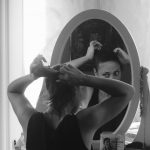I have been living in Wroclaw for about five years now. I chose this city because it wasn’t that far from my family home and it had courses that interested me. I must admit, however, that from the very beginning I was captivated and knew that I would stay here for longer. Apart from the city itself, I was impressed by the people, their diversity and how open they are. Also, there are a lot of tourists coming from the west, including the Netherlands.
One time, when I was out with some friends, we happened upon a new bar that was located in the market square. It wasn’t a big place, so it wasn’t difficult to hear the conversations of the people sitting next to us. What caught our attention, however, was a group of guys who spoke Dutch. As we were learning Dutch, we reacted very enthusiastically and decided to talk to them.
They wanted to talk to us as well, so we were sitting together for a good two hours, but there was a small problem. When they heard that we were learning Dutch, they switched from English to their native language and expected us to do the same. However, our language skills were not even half as good as theirs, which made it harder for us to talk and definitely made us less free. Because of the stress and the late hour it was hard to form a grammatically correct sentence, so we switched back to English.
It is rare to have such an opportunity to test your language skills with someone who has known the language since birth. The barrier in this situation, however, was our poor knowledge of the language, which was even more apparent due to the stress.
When we learn a language, grammar (unfortunately) is an integral part of it. Even if you know a lot of vocabulary, without the ability to combine words correctly, you won’t form a sentence. However, you don’t have to worry about a whole bunch of rules that you’ll have a hard time remembering.
Dutch grammar is very similar to that of more common foreign languages, such as English or German. All three have similar types and grammatical structures, and on top of that, Dutch borrows a lot from these two languages.
There is even more good news! The grammar of the Dutch language is much easier than that of English. Especially at the beginning you should not be too worried about it, as none of the structures lead to problems with understanding.
In this article I will present the most difficult issues in Dutch grammar, and at the end I will give you a hint on how to learn it all easily (without learning the grammar rules).
Conjunction of verbs
The verb is the most important part of language. A sentence must contain a verb to be a sentence. A sentence without a verb is not a sentence. Actually, a verb by itself can be a sentence, for example: “Sing!” or “Stop!”.
Verb conjugation is the way a verb changes when we use it in different sentences. In linguistics we talk about its conjugation through modes, tenses, persons, numbers, sides and other grammatical categories.
The most important and frequently used verbs (including “to have” and “to be”) are very irregular, so the only way to get used to them is to learn all the forms by heart.
For details, please read the article “Conjugation of Dutch verbs“. There, you will find more examples and detailed explanations to help you understand everything.
Articles
In Dutch, every noun must be preceded by an “article”, which determines the grammatical gender of the noun. We have two definite articles, “de” and “het”, and one indefinite article, “een”. “De” is used for masculine and feminine genders and “het” for neuter genders, e.g.:
- het boek – the book
- de man – the man
- de vrouw – the woman
We also use articles in English, but there is only one definite ‘the’ and one indefinite ‘a’ (and its variation ‘an’).
It takes years to learn when to use a masculine/feminine article and when to use a neuter one”, and the only way to know which gender article to use in each case is to learn the article together with the noun.
There are many rules and details. If you are interested in this topic, please read the article “When to use “De” and “Het” in Dutch”.
Sentence formation
Sentence formation is the arrangement of words in a sentence and their order.
Usually sentences (i.e. the so-called singular sentences) have a simple formation and are constructed in the same way as in English, where the verb (i.e. the statement) comes immediately after the doer of the action (i.e. the subject). For example:
| Dutch | English |
|---|---|
| Hij is jong. | He is young. |
| Ik heb veel geld. | I have a lot of money. |
| Jullie spreken Nederlands. | You guys speak Dutch. |
Much more problematic are compound sentences, especially those linked by conjunctions such as “omdat” (because), “dat” (that), “hoewel” (although), “als” (if), etc (there are quite a few of these).
In sentences of this type, the verb (or verbs) lands at the end of the sentence, e.g.:
| Hoewel hij jong is, is hij erg rijk | Although he is young, he is very rich. |
| Ik ben rijk, omdat ik veel geld heb. | I am rich because I have a lot of money. |
| Ik weet dat jullie Nederlands spreken. | I know that you guys speak Dutch. |
It takes a long time to automate this rule, and even people who have lived in the Netherlands for many years still put the verb directly after the subject. On the one hand, there is no need to worry about it, because such a sentence, even though it is not ‘grammatical’, is perfectly understandable.
On the other hand, we would like to speak grammatically. And here it turns out that the best way is not to learn grammatical rules, but to memorise whole example sentences, such as the one above. After learning a dozen or so sentences representing a given grammatical issue, our brain is able to produce the rule itself, so that more often than not we use it in conversation without knowing it consciously – exactly like in our mother tongue.
If you are interested in the details, we invite you to read the article “The best way to learn a foreign language is through sentences“

.
Separate compound verbs
Separable verbs are those that consist of two parts: a prefix and a verb, e.g.:
- ankommen (aan + kommen) which means “to arrive”
- schoonmaken (schoon + maken) which means “to clean”
- opgeven (op+geven) which means “to give up”
These verbs are problematic because when we use them in sentences, we have to separate the prefix from the verb:
| Dutch | English |
|---|---|
| Ze komt om 10 uur aan. | She arrives at 10 am. |
| Hij maakt zijn woning schoon. | He cleans his house. |
| Geef nooit op! | Never give up! |
Note that, just like in English, the meaning of these verbs is not derived from the meaning of the verb it contains, e.g. “geven” means “to give” and has nothing to do with “to submit”. The best way to learn that is to repeat using Spaced Repetition.
Adjectives
An adjective is a word that gives characteristics to persons or things, e.g: “groot” (big), “mooi” (nice), “rijk” (rich), “lang” (long).
In Dutch, when we use an adjective before a noun (i.e. a person or object) we have to add an ‘e’ ending to the adjective:
- lange boek
- grote man
- mooie vrouw
But not always, and the exception is a very tricky rule, which sounds easy, but is very difficult to use, especially when speaking. Namely, we do not add an ‘e’ ending if the noun has the article ‘het’ and it is used after an indefinite article, e.g:
- de grote man — een grote man (“man” has the article “de” so we add “e”)
- het grote boek — een groot boek (“boek” has the article “het” so we do not add “e”).
This rule is problematic for two reasons:
- the change follows the indefinite article, which is the same for “de” and “het”;
- knowing which nouns are “de” and which are “het” is a problem in itself.
Our tip when you are not sure: always add an “e” ending! Most nouns have a “de”, so you have about a 75% chance.
Best way to learn Dutch grammar
Dutch grammar, as in any other language, has quite a few rules, principles and exceptions. It is useful to know these rules in order to know why the sentence looks the way it does and not different. In our Taalhammer app you will find articles about Dutch in a more expanded version than above. Taalhammer is also compatible with the Shadowing Method.
However, that is not all. In order to develop the reflex to speak correctly, it is best to learn complete sentences by heart. In this way, as well as memorising the whole phrase, we also become familiar with the arrangement of the different parts of speech and how and with what they are combined.
The Taalhammer app specifically places the emphasis on learning whole sentences. First, you learn words and phrases. Later, we train you on how to combine these words into sentences, using patterns of grammatical structures in different variations. Only later do we briefly present the grammar rule in the form of a reference. At the very end, the app offers you texts to listen to that contain the words and sentences you have learned.
Learning in this way comes in handy especially when conversing in a foreign language, and in particular when the situation becomes stressful. It will allow you to draw out an entire sentence from memory in a fluent and confident manner. If you are interested in the details of learning a language, please see the article “How polyglots learn languages“.







